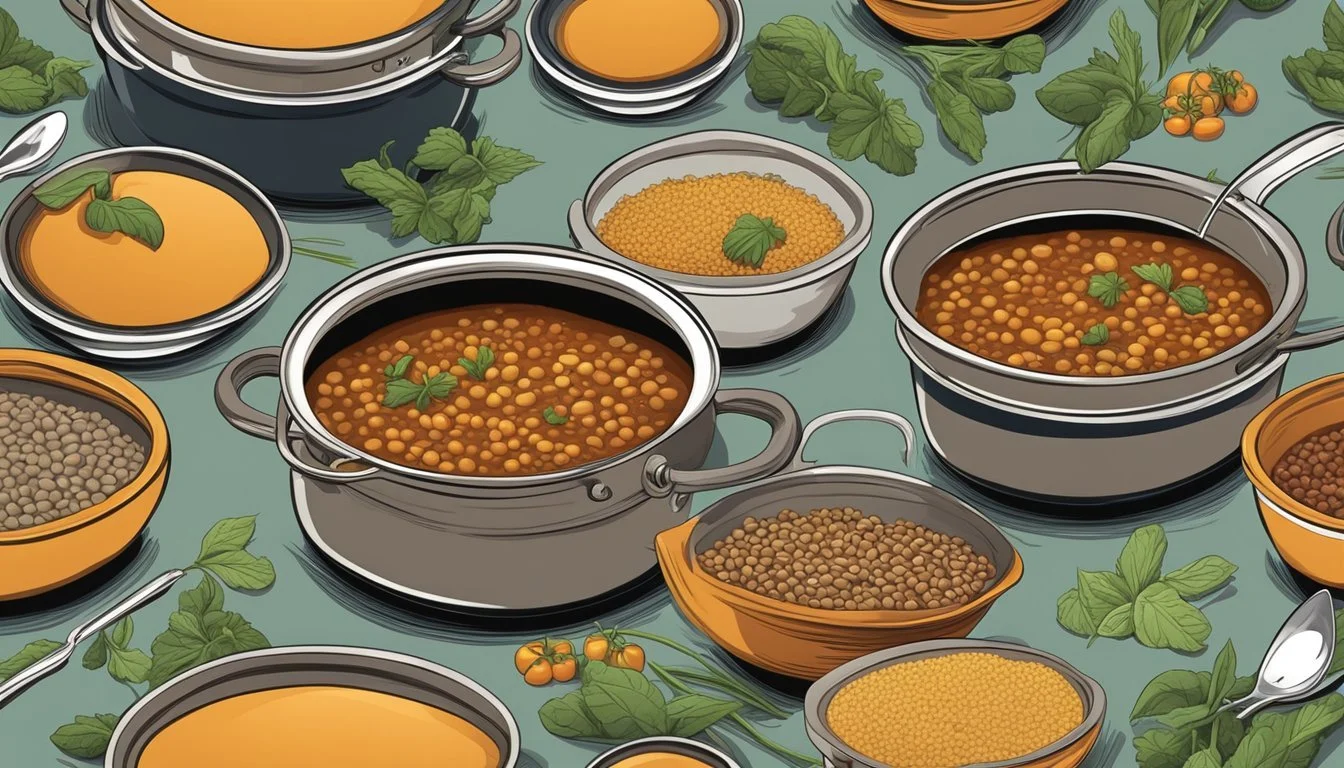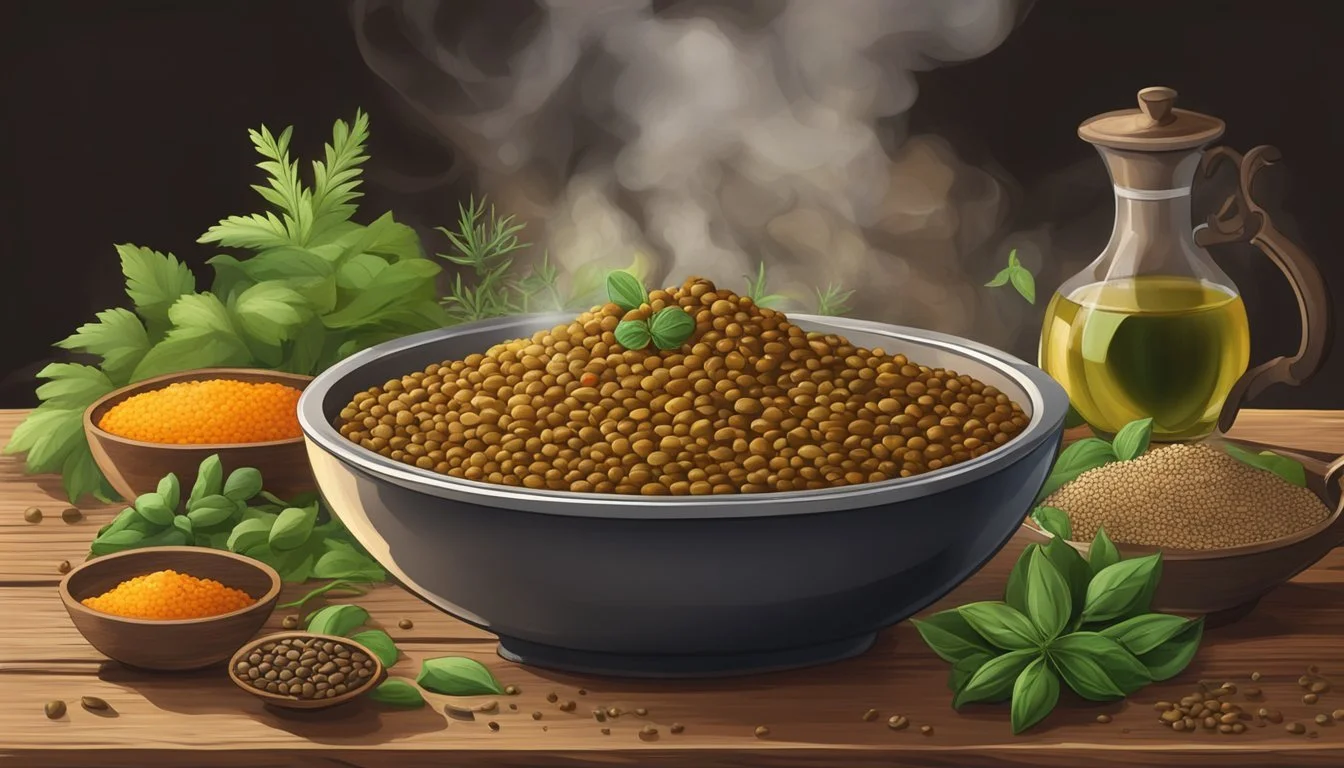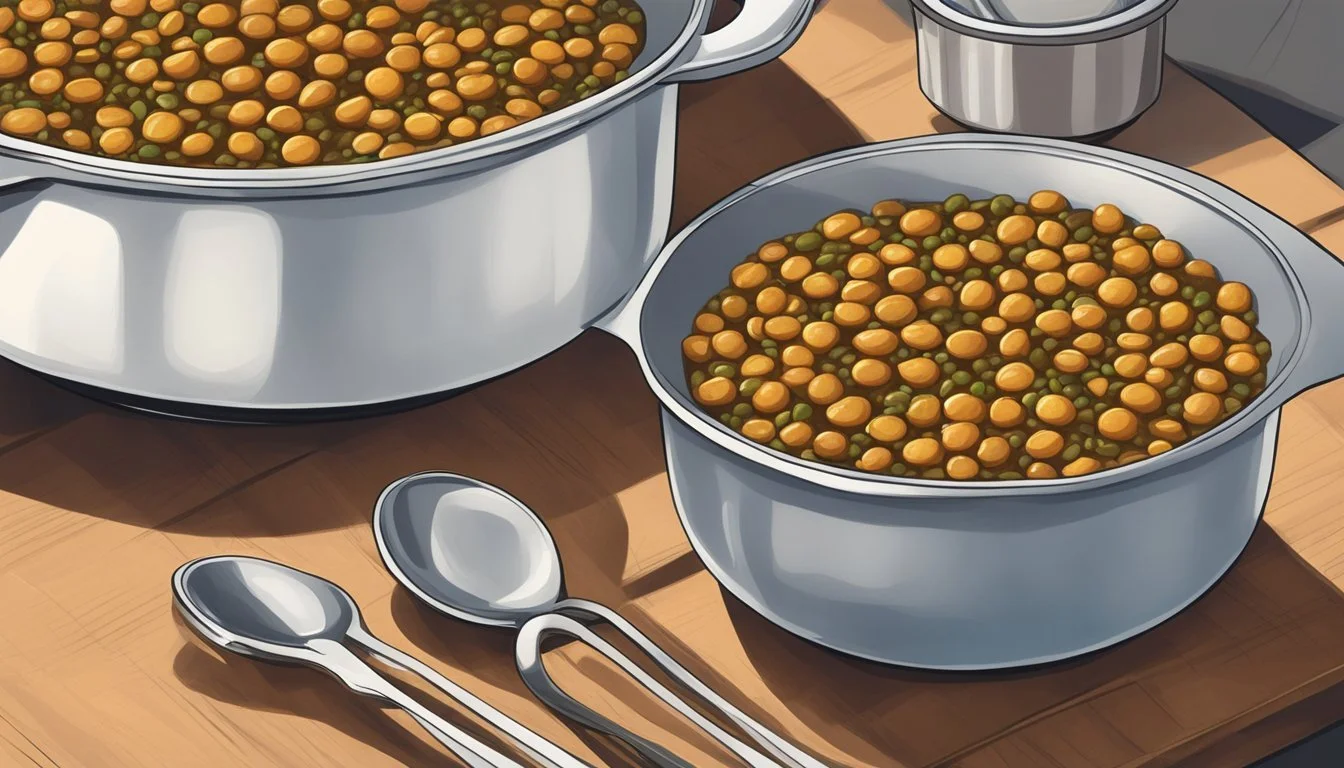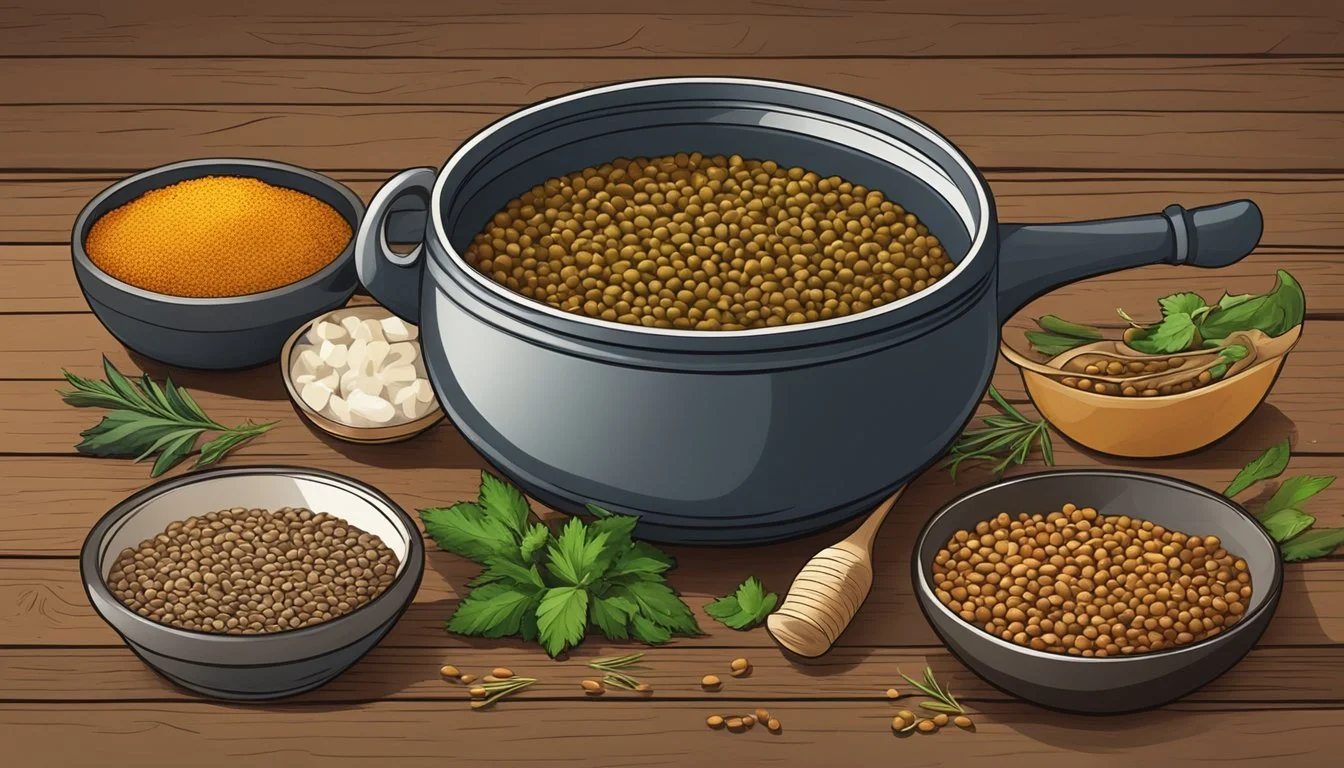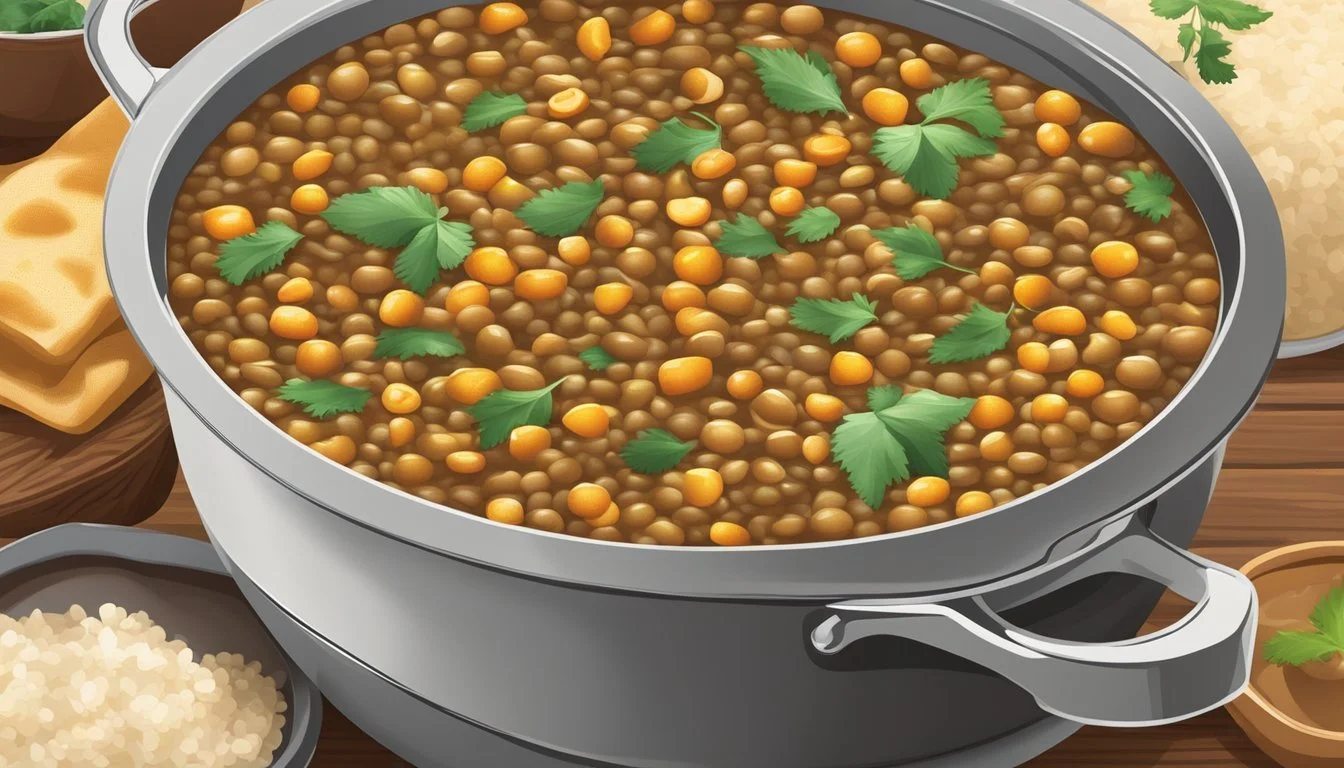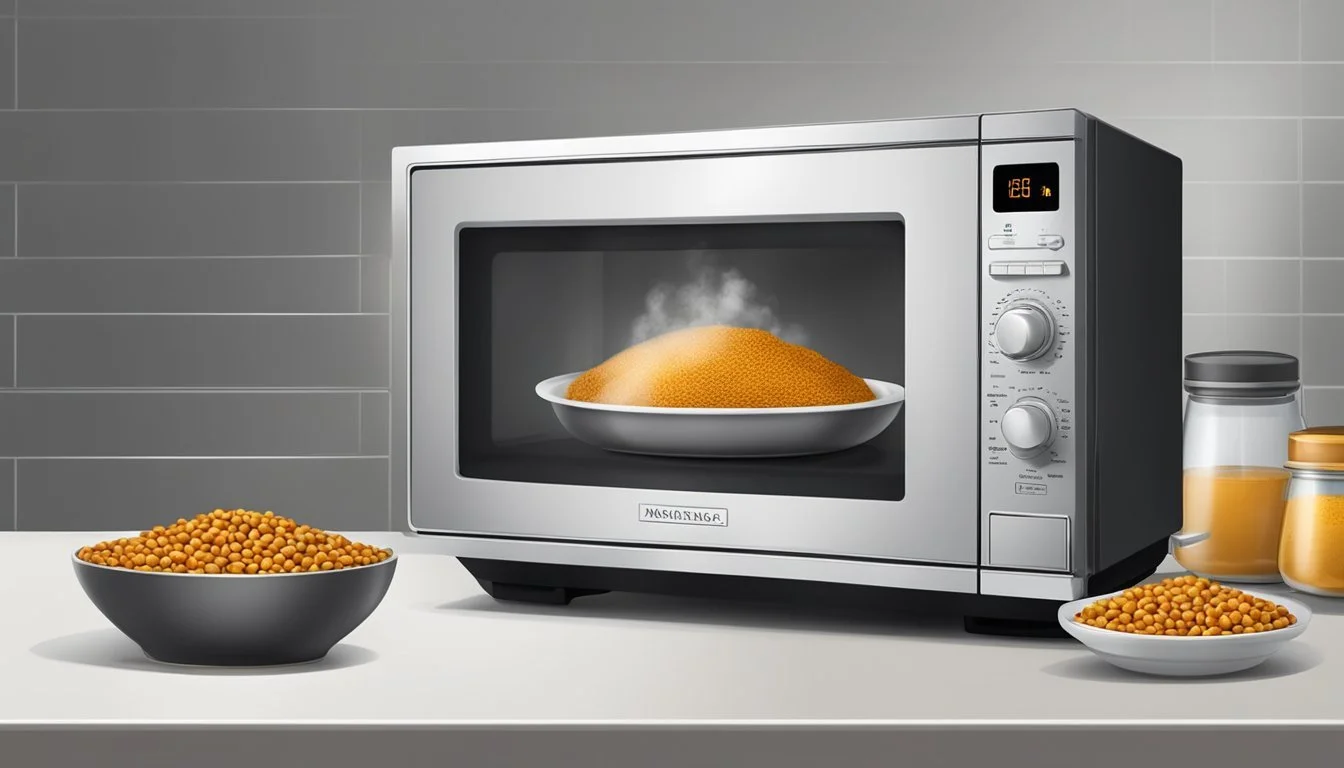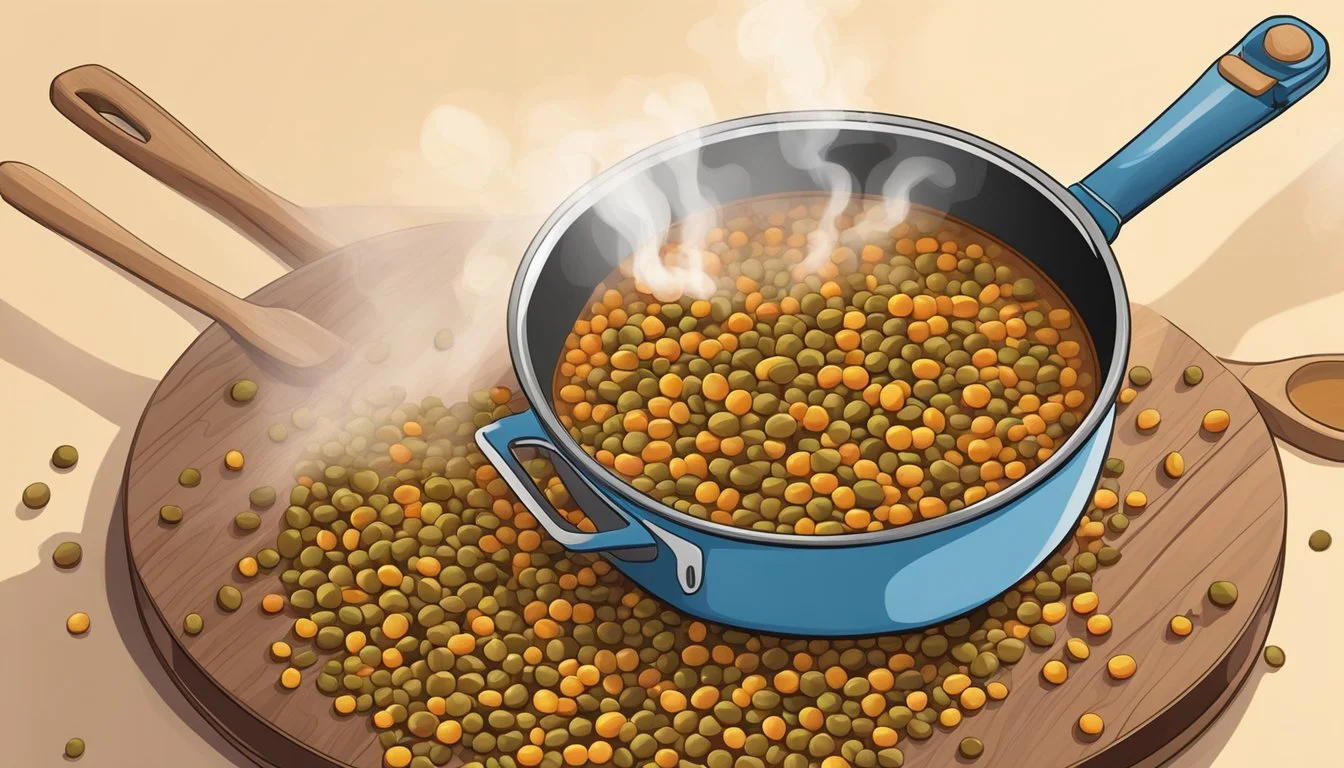Best Way to Reheat Madras Lentils
Ensuring Flavorful Warmth Without Losing Spice
Madras lentils, a spiced and hearty dish, are not only cherished for their rich blend of flavors but also for their high protein and fiber content, making them a popular choice among vegetarian and vegan diets. Often composed of a warm mixture of lentils, red kidney beans, and a variety of aromatic spices, Madras lentils can be a wholesome part of any meal. The challenge lies in reheating this delicacy without losing its depth of flavor or compromising its texture. Achieving this requires a gentle approach that respects the integrity of the ingredients and the complexity of the dish.
The key to preserving the flavor of Madras lentils during reheating is to employ methods that retain moisture and evenly redistribute heat. Whether the lentils are homemade or from a canned variety, the process should ensure that the lentils remain moist and that the spices within the dish stay vibrant. A careful balance of temperature and cooking time is vital to prevent the lentils from becoming too dry or mushy, which is why choosing the right reheating technique is essential.
For the best results, lentils can be simmered on the stove or warmed in an oven. On the stove, lentils benefit from gentle heat and the addition of a small amount of water or broth to maintain moisture. In the oven, covering the dish with foil can prevent drying out. Both methods allow for the flavors to meld together as the dish is slowly brought back to temperature, preserving the distinct taste that Madras lentils are known for. Understanding the nuances of these techniques will ensure that even leftover lentils can be savored with as much enjoyment as they were when freshly made.
Understanding Madras Lentils
Madras Lentils, an Indian-inspired dish, are known for their rich, savory flavor profile. They encompass a blend of whole lentils and red kidney beans, creating a hearty texture that is both satisfying and nutritious.
Key Ingredients:
Lentils: The base of the dish, providing protein and a creamy texture.
Red Kidney Beans: Add a distinct bite and additional protein.
Tomato Paste/Sauce: Offers a tangy foundation to the spices.
Cilantro: Used as a garnish, it brings a fresh and herbaceous note.
The spices used in Madras Lentils are pivotal to its authentic taste.
Essential Spices:
Cumin: Ground cumin imparts a warm, earthy tone that is central to the flavor.
Ginger: Whether dried or fresh, ginger adds a zesty kick and a subtle spiciness.
The preparation technique typically involves slow cooking, which allows the spices to infuse into the lentils and beans, producing a complex flavor characteristic of the Madras region.
Cooking Tip: To maintain the layered spice profile when reheating, one should gently warm the Madras Lentils over low heat, stirring occasionally to prevent the loss of moisture, which can diminish the vibrant flavors.
In summary, Madras Lentils are a fusion of nutritional ingredients and bold spices, where cumin and ginger play starring roles. The use of cilantro adds a refreshing contrast to the warm, spiced base of the lentils and kidney beans, culminating in a dish that is as aromatic as it is flavorsome.
Selecting Ingredients for Reheating
When reheating Madras lentils to preserve their spiced and hearty taste, one should carefully select ingredients that complement the dish’s complex flavor profile. The goal is to maintain the integrity of the original dish while ensuring that the reheated version is just as satisfying.
Choosing the Right Lentils
It is imperative to use lentils that retain their shape and texture upon reheating. For Madras lentils, brown lentils or green lentils are preferable because they are less likely to become mushy compared to red lentils. One should ensure that the lentils are reheated gently to avoid overcooking. If kidney beans are a part of the original recipe, they should also be reheated with care as they add a distinctive texture and are crucial for authenticity.
Optimal Spices for Retaining Hearty Flavor
Spices are the soul of Madras lentils, and one must be meticulous in heating them to reinvigorate their flavors. Key spices like cumin, coriander, turmeric, and garam masala should be present. To recharge these spices' essence during reheating, a small quantity of oil can be utilized to lightly sauté them before adding the lentils. This process, known as blooming, releases the spices' aromatic oils and deepens their flavors in the dish. The inclusion of aromatic elements such as onions, which should be sautéed until they are translucent, and tomato paste, to add richness, can assure that the lentils' complex flavor is well preserved after reheating.
Preparatory Steps Before Reheating
Proper storage and temperature acclimation are crucial to preserving the rich flavors and textures of Madras lentils during the reheating process. It ensures that when they're subsequently warmed, they retain their spiced and hearty qualities.
Storing Leftovers Properly
When storing leftover Madras lentils, one should place them in the fridge in an airtight container to minimize exposure to air and moisture. This step is vital to prevent bacterial growth and flavor loss. The lentils should be cooled to room temperature before sealing them and placing them in the fridge to maintain their quality.
Bringing Lentils to Room Temperature
Prior to reheating, it's advantageous to bring the lentils to room temperature, which can enhance the warming process. Remove the airtight container from the fridge and let it sit out for about 15-20 minutes. Attaining a modest starting temperature can help in achieving more even heating when using the stovetop or other reheating methods, ensuring the leftovers heat thoroughly without overcooking the edges while the center remains cold.
Reheating Techniques for Best Taste
When reheating Madras lentils to preserve their flavor and texture, selecting the correct reheating method is crucial. Each technique provides a different benefit, whether you're looking for convenience or aiming to keep the lentils' hearty spice intact.
On the Stovetop
To reheat Madras lentils on the stovetop, the individual should use a pot or skillet, adding a splash of water or broth to prevent the lentils from drying out. They should gently warm the lentils over medium heat, stirring occasionally to ensure even heating. This method helps maintain the spiced flavor and robust texture of Madras lentils.
Using a Microwave
For a quick option, the microwave can be used. Place the Madras lentils in a microwave-safe dish, lightly covering them with a lid or microwave-safe plastic wrap to retain moisture. One should heat the lentils in short intervals, usually 1-2 minutes, stirring in between to distribute heat evenly without diminishing their rich taste.
Slow Cooker Method
A slow cooker can warm Madras lentils evenly while enhancing their deep flavors. The individual should add the lentils with a little broth or water to avoid them becoming too thick or dry. They can set the slow cooker on a low setting, allowing the lentils to gradually come up to temperature, which can take a couple of hours.
Oven Reheating
When using an oven to reheat Madras lentils, they should be placed in an oven-safe dish. To retain moisture, the lentils should be lightly sprinkled with water or broth. Cover the dish with foil and heat at a moderate temperature, typically 350°F (175°C), for about 10-15 minutes, or until they are thoroughly warm. This method helps sustain the original quality of the lentils.
Maintaining Texture and Moisture
When reheating Madras lentils, preserving their moisture and taste is crucial to maintaining the dish’s hearty and creamy attributes. Proper techniques ensure the lentils remain soft and flavorful.
Adding Liquids While Reheating
It is important to add a small amount of liquid to the lentils during the reheating process. This could be in the form of water or broth. The key is to use just enough to maintain moisture without diluting the taste. To illustrate:
Oven Reheating: Mix in 2-3 tablespoons of broth or water per cup of lentils before covering and heating.
Stovetop Reheating: Start with a splash of liquid and add more as needed, stirring occasionally to prevent sticking.
Avoiding Overheating
Overheating can compromise the lentils’ texture, turning them mushy. To avoid this:
Microwave: Heat in short intervals (30-60 seconds), stirring in between to distribute heat evenly.
Stovetop: Use a gentle simmer and avoid boiling, heating just until the lentils are warm throughout.
Pairing with Side Dishes
When reheating Madras lentils, selecting the right side dishes is crucial for complementing their hearty and aromatic nature. The side dishes should not overpower the lentils, but rather enhance their rich, spiced flavor.
Rice and Grains
Madras lentils, with their robust flavor profile, blend seamlessly with rice and various grains, creating a balance both in texture and taste.
Coconut Rice: The subtle sweetness and fragrance of coconut rice pairs excellently with the spiciness of the lentils.
Brown Rice: For a healthier option, the chewy texture and nutty flavor of brown rice serves as a splendid base for the lentils.
Quinoa: A protein-rich alternative, quinoa complements the lentils without competing for attention on the palate.
Breads and Flatbreads
Breads and flatbreads serve as an absorbent and neutral-tasting vehicle for Madras lentils, perfect for scooping up the hearty mixture.
Naan: A classic pairing, the soft and pillowy naan bread can be used to sop up the lentils and enjoy their full flavor.
Grilled Flatbread: The slightly crisp texture of a grilled flatbread adds a delightful crunch contrasting the creamy lentils.
When considering greens, a simple spinach salad dressed lightly with vinaigrette can provide a refreshing counterbalance to the warm spices in the lentils. In the realm of salads, options that incorporate tangy and crisp elements can cleanse the palate between flavorful bites of Madras lentils.
Agents of Flavor: Spices and Aromatics
In the realm of Madras lentils, spices and aromatics play an essential role in harnessing the dish's signature taste. Proper integration and choice of fresh versus dried variants are crucial to ensure the flavors are vivid and authentic during the reheating process.
Integrating Spices During Reheating
When reheating Madras lentils, it's important not to let the spices overpower the dish. They should complement and enhance the lentils and beans. Here are steps to maintain the balance of spices during reheating:
Begin with a Warm Base: Gently heat the lentils to a moderate temperature.
Add the Spices: Sprinkle in a small amount of ground cumin and smoked paprika to enliven the dish without dominating the original flavors.
Stir Gently: Ensure the spices are evenly distributed to avoid clumping and to allow the heat to unlock their aromatic oils.
Using Fresh Versus Dried Aromatics
The decision to use fresh or dried aromatics can impact the depth of flavor in the dish.
Garlic and ginger: Peel and mince finely before adding to the lentils, releasing vibrant notes.
Tomato Sauce: A scoop can brighten and intensify the taste as it incorporates into the warm mix.
Effective when fresh options are not available; dried aromatics should be used sparingly as their flavors are more concentrated.
Rehydrate by sprinkling them into the lentils and allowing them to absorb moisture during the reheating.
Both fresh and dried aromatics serve to enrich the Madras lentils, each lending distinct nuances that can enhance the dish when used thoughtfully.
Serving Suggestions for Madras Lentils
Madras lentils are known for their richly spiced and hearty taste. Serving them with the perfect garnishes and adjusting their texture and spice level can enhance the dining experience.
Garnishes and Toppings
For a burst of flavor and a pleasing texture in every bite, consider adding fresh garnishes and toppings to the Madras lentils. Finely chopped onion adds a pleasant crunch and pungency, which complement the spices in the lentils. A dollop of yogurt or a splash of coconut milk can provide a cooling counterpoint to the dish’s heat while adding a creamy texture. Additionally, a sprinkle of fresh herbs, such as cilantro, can offer a bright note to balance the savory depth.
Onions: Diced raw or fried
Dairy: Yogurt or coconut milk for creaminess
Herbs: Cilantro or parsley for freshness
Adjusting Thickness and Spice Level
The consistency of Madras lentils can be altered to suit individual preferences. If the lentils are too thick, one can gently stir in a small amount of vegetable broth to reach the desired consistency without diluting the flavor. For those who prefer a milder spice level, incorporating additional coconut milk can help temper the heat while contributing to a creamier texture.
To thin: Add vegetable broth (1 tablespoon at a time)
To reduce spice: Stir in extra coconut milk (1 tablespoon at a time)
Health Benefits and Nutritional Value
Madras lentils are not only a flavorful component of many diets, but they are also a powerhouse of essential nutrients that contribute to overall health.
Madras Lentils in a Balanced Diet
Madras lentils, a spiced dish originating from Southern India, often include a blend of lentils, tomatoes, cream, and spices. This dish can fit seamlessly into a balanced diet as a source of plant-based protein and fiber, which are vital for muscle repair, energy, and digestive health. Regular consumption of lentils as part of a wholesome diet helps maintain energy levels and supports bodily functions efficiently.
Nutrients in Lentils and Their Advantages
Nutrient Benefits Protein Supports muscle growth and repair. Fiber Aids digestion and promotes satiety. Iron Crucial for oxygen transport in the blood and energy release. Potassium Helps regulate fluid balance and blood pressure. Vitamins Various B vitamins in lentils support metabolic processes.
Lentils are not only delicious but also rich in iron, which is important for preventing anemia and maintaining healthy blood cells. The potassium content assists in cardiovascular health by managing blood pressure levels. They provide a substantive amount of vitamins, particularly from the B-group, which are integral to energy metabolism. The high protein content makes them an excellent choice for individuals looking to complement or replace animal proteins in their diets.
Avoiding Common Reheating Mistakes
When reheating Madras lentils, ensuring the preservation of their spiced flavor and hearty texture while preventing bacterial growth are paramount.
Ensuring Even Heating
To reheat lentils evenly, one should stir them periodically during the reheating process. Whether on the stove or in the microwave, this prevents cold spots where bacteria can survive and ensures that all lentils reach the proper temperature.
Stovetop: Heat the lentils on a medium setting, stirring frequently to distribute heat.
Microwave: Stir the lentils in between 30-second heating intervals to maintain an even temperature.
It's also beneficial to add a small amount of water or broth before reheating to regain moisture lost during storage.
Preventing Bacterial Growth
To inhibit bacteria, one should avoid leaving lentils at room temperature for prolonged periods. Lentils should be refrigerated within two hours of cooking. When reheating, they need to be heated to 165°F (74°C) to ensure safety.
If lentils have been stored cold, they should be handled carefully:
Gently rinse in a colander to remove any excess starch that may have solidified during refrigeration.
Refrain from reheating lentils multiple times as temperature fluctuations encourage bacterial growth.
Using these methods will help maintain the quality and safety of reheated lentils.
Alternative Uses for Leftover Madras Lentils
Leftover Madras Lentils offer a versatile base for creating new and comforting dishes. With their robust spices and hearty texture, they can easily be repurposed into heartwarming soups or given a new life in a variety of traditional recipes with an innovative twist.
Transforming into Soup or Chili
One can simply transform a batch of leftover Madras lentils into a nourishing soup by adding vegetable broth and additional vegetables. Simmering the mixture will allow the flavors to meld and create a warm, soothing meal. To create a chili, one can incorporate a can of diced tomatoes, more spices, and potentially some red kidney beans into the lentils. Letting the chili simmer will thicken it and deepen the flavor profile.
Soup Transformation:
Add 2 cups of vegetable broth per cup of leftover lentils.
Optional: Include vegetables like carrots, celery, and spinach.
Stir in one can of diced tomatoes and a can of kidney beans to the lentils.
Add extra spices as needed, such as chili powder or cumin, and allow to simmer until thickened.
Innovative Twists on Traditional Recipes
The spice-infused leftovers can provide an excellent foundation for a creamy tomato sauce. Blend the lentils with tomato sauce and cream to achieve a luxurious texture that pairs well with pasta or as a base for a baked dish. Also, they can be incorporated into a variety of traditional dishes, adding a nutritious and flavorful twist to the meal.
Creamy Tomato Sauce:
Blend lentils with 1 cup of tomato sauce and 1/4 cup of cream per every 2 cups of lentils.
Serve over pasta or as a base for vegetable bake.
These diverse applications ensure that not a single spoonful of Madras lentils goes to waste, while also providing home chefs the opportunity to flex their culinary creativity. Leftovers don't have to be mundane; with Madras lentils, they become an opportunity to explore new flavors and reimagine comfort food.
Preserving and Extending Shelf Life
Madras lentils, with their rich spices and hearty taste, can be preserved effectively to maintain their quality. Using proper freezing and thawing techniques, along with correct storage methods, ensures these pantry staples remain as vibrant and flavorful as when they were first prepared.
Freezing and Thawing Techniques
Freezing Madras lentils is a reliable way to extend their shelf life without sacrificing taste. When freezing, let the lentils cool to room temperature. Next, partition them into portion-sized airtight containers or resealable freezer bags to prevent freezer burn and maintain quality. Thawing should be done in the refrigerator, allowing lentils to gradually reach the optimal temperature before reheating which preserves their texture and taste.
Cool lentils to room temperature
Divide into portion-sized airtight containers or resealable freezer bags
Freeze
Thaw in the refrigerator before reheating
Proper Storage Methods
For lentils that are not meant to be frozen, store them in a cool, dry place such as a pantry. Pantry staples like lentils fare best when kept in an environment with a temperature between 10°C to 21°C (50°F to 70°F) and a low humidity level, preferably below 15%, to prevent the lentils from becoming damp or moldy.
Temperature: Keep between 10°C to 21°C (50°F to 70°F)
Humidity: Maintain a level below 15%
Correct storage in a pantry involves sealed containers – vacuum-sealed if possible – that shield the lentils from air and moisture. Regular checks for signs of spoilage such as a musty smell or visible mold will help ensure the lentils remain safe for consumption.
Tips for Quick and Easy Reheating
Heating up Madras lentils shouldn't dampen their robust spiced flavor or turn meal prep into a lengthy task. Below are streamlined methods to reheat this spiced and hearty dish swiftly, without losing taste or quality, perfect for a convenient weeknight dinner.
Efficient Reheating Shortcuts
Microwave: Place lentils in a microwave-safe bowl, adding a tablespoon of water to avoid drying out. Cover with a vented lid and heat for about 2 minutes on high, stirring halfway through.
Stovetop: In a saucepan, combine lentils with a splash of water or broth. Warm on medium heat, stirring occasionally, for about 5 minutes until thoroughly heated.
For those seeking a tasty bite quickly, these methods are ideal, keeping Madras lentils flavorful and moist.
Preparation Tips for Busy Lifestyles
Batch Cooking: Prepare lentils in advance and store portion-sized servings. Refrigerate up to one week or freeze for longer storage.
Quick Thawing: For frozen lentils, defrost in the refrigerator overnight or for a quick option, use the microwave's defrost setting.
Utilizing these preparation tips ensures that a delicious and easy Madras lentil dish is just moments away, ready to provide a quick and convenient meal option, even on the busiest of evenings.
Conclusions
Reheating Madras lentils effectively is essential to preserve their deeply spiced flavor and satisfying texture, making them a perfect choice for a hearty weeknight dinner. One can confidently utilize several methods, each suited to specific circumstances and kitchen equipment availability.
Oven Method: Gently reheating in a covered oven-safe dish with a bit of water or broth prevents the lentils from drying out. Uncovering and broiling briefly crisps the top layer, revitalizing the dish's texture.
Stovetop Method: Simmering the lentils in a saucepan, potentially with additional seasoning, can rejuvenate the spices and is quick for weeknight urgency.
Microwave Method: For speed and convenience, especially when reheating a single portion, covering the lentils and using moderate power settings can maintain their moisture.
Each method requires vigilance to ensure that the lentils do not overcook or dry out, as this can significantly diminish their quality. By using these techniques, one can enjoy Madras lentils that retain the robust flavors of their spices and the hearty satisfaction of a well-prepared lentil dish. A knowledgeable cook understands that careful reheating is the final step in honoring the original culinary effort that went into preparing Madras lentils.

